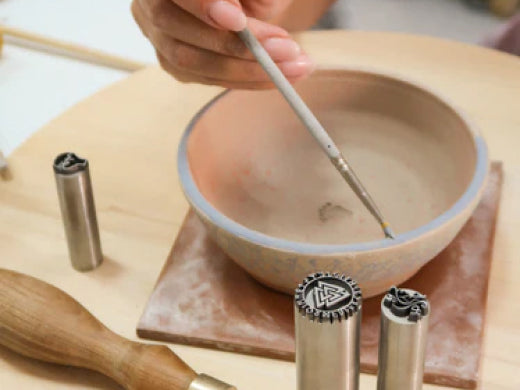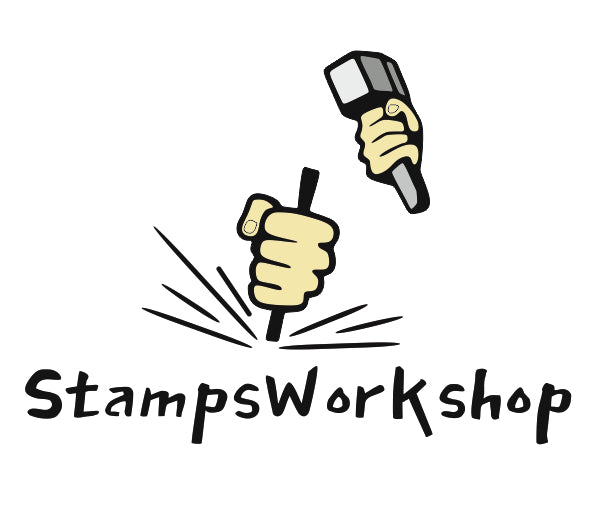
How to Stamp Clay?
The clay stamping process is quite simple and fun. You can get unique items with company logos, original images, or even ornaments using a custom pottery stamp. However, you should understand the key features of the process to get the results you expect. Let's talk about it in detail right now!
Which Factors Influence the Result?
Purpose of Stamping
As a rule, there are two purposes for products’ clay stamping. You can use pottery stamps to apply decor and logos or modify the surface structure by changing the other side of the wall. Each process requires an individual approach.
Clay Characteristics
Another factor is the material’s hardness. The stamping result largely depends on it. The hardness of the clay determines its ability to deform and directly affects the image's quality. In addition, the thickness of the material affects the result. Support of the treated surface or its absence requires adjusting the process.
Stamp Characteristics
The material used to make the custom clay stamp as well as the size and shape of the applied image matter a lot. Additionally, remember about the considerable role of the stamping technology you will use.
How to Apply a Logo to Clay?
Product branding is one of the most common uses of clay stamping. Its main goal is to highlight the product’s uniqueness while keeping its structure. So, what should you remember to get a sharp logo on a clay surface?
- Try to apply the image to clay that is moderately dry. The matter is that too soft material will add sloppiness to the logo and may stick to the stamp, while too dry material will not allow you to get a distinct picture even if you use the best pottery tool.
- Choose a thicker material section or an area that contacts additional supporting elements for your logo. Thus, you’ll get a sharper and more voluminous pattern, avoiding significant deformation of the clay surface.
- Choose compact stamps. The larger the size of the logo applied, the higher the likelihood of noticeable deformations. How can you prevent surface structure changes? If the image is too large, use one of its parts or design a miniature logo just for stamping.
- Use the optimal stamping technique depending on the product structure:
- if the thickness of the area or the support allows, you can press the stamp for pottery with moderate force, trying to evenly distribute the pressure;
- if there is no support or the wall of the product is thin, you should try to minimize potential deformation. Do it by applying pressure to the smallest possible area or try placing the stamp at an angle to the surface and gently rolling it around.
Principles of Clay Stamping to Change Surface Designs
Generally, stamping to change surface characteristics (the other side of the wall) can be done using similar principles. However, often, you need to apply a logo to the image and also make the wall structure unique. In this case, clay stamps will also help. How does the surface modification process differ from classic branding?
- Consider the plasticity of the material. Wet clay is considered more prone to changes in shape, while dry clay is more likely to crack when you try to deform it. At the same time, ensure that the material is not too wet. Otherwise, the structure of the selected area and neighboring ones may change, or the clay will stick to the stamp.
How can you achieve the required humidity? First, try drying items upside down to help the outer walls dry faster. Secondly, before stamping, you can wet the inner surface with water to make it more pliable.
- Don't neglect additional support. Though, in this case, a change in the wall structure is welcome, the support will help maintain the product's original shape without significant deformation.
- Choose clay-safe stamps. The best solution is tools with rounded edges. They provide a smoother, gentler dive by reducing pressure on the clay and preventing walls’ damage.
- Make the stamping process extremely precise. Focus your efforts on one area and slowly roll the stamp with minimal pressure. Why is it better to change the wall structure this way? Doing it quickly can lead to deformation of the entire surface, even if you did not plan it.
Conclusion
The process of working with clay stamps can vary depending on your purpose and the material’s characteristics. You should start transforming the product only after deciding on the result. Be sure to consider clay’s characteristics and follow the basic rules of stamping technology. Remember that impulsiveness and haste are not your best friends on this creative path. Hopefully, these simple recommendations will help you implement ideas of any complexity. Good luck!
